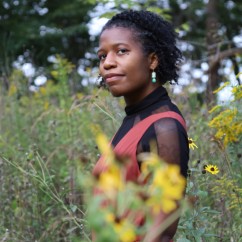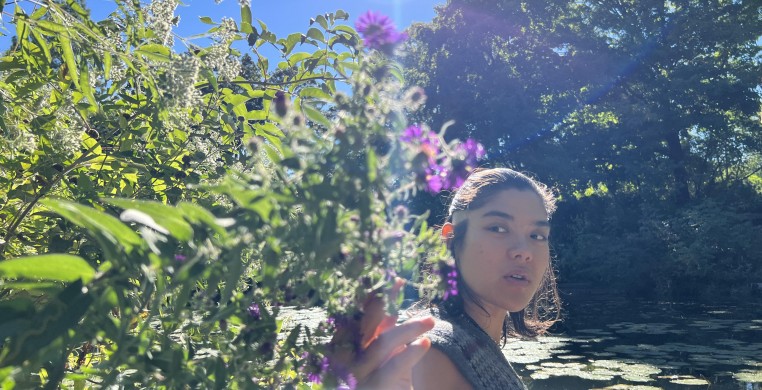Co-MISSION Works-In-Progress presented resident artists Eshan Rafi, Jamila Kekulah, and AiRos 頌恩 medill (performing as ZIRán) at Links Hall this past December 15th.
They have been developing their work since September and will again present their investigations in Spring 2024. At the end of the night, there was a talk back presented by the Artist Programs Manager and Associate Curator Aaliyah Christina. Audience members expressed gratitude to the artists for sharing such personal work that conveyed distinct cultural backgrounds and unique research inquiries.
While each resident artist presented a different performance from the others, a unifying thread that wove the split bill together was collectivity. The artists individually created works that brought the audience into communion with their performance, which expanded their presence beyond the fourth wall. While each performance IS a work in progress that will continue to evolve, the bill felt like a well curated show with a central theme.
Top of the bill was Eshan Rafi, whose work explored politics. The performance began with a collective reading, read aloud by the audience, of three stories recounting their father’s life growing up in Pakistan, and its political and cultural residues. The work also included Rafi delivering a Presidential speech, and a mapping of the space through gestural movements.
It is unclear if the space mapping was choreographed or improvised, but Rafi's internal focus demonstrated that it was a self-centered practice. A deep connection to the artist’s movement created a palpable intensity, and as the audience followed the invisible trajectories of Rafi, they began to create their own communal map of the space.
Another highlight was the connection born from the audience reciting the memoirs of Rafi's father. The awareness of one's neighbor while sharing the personal words aloud made for a distinctive experience.
 Eshan Rafi, Photo by Domenic Del Carmine
Eshan Rafi, Photo by Domenic Del Carmine
Each part of the work made a powerful impact on the viewer, but when seen consecutively the presentation felt disjointed and without a clear thesis. Rafi’s further investigation into the core research question (and how these various practices presented by Rafi) is sure to evolve into a deeply enriching experience.
Jamila Kekulah presented their work next. "Lay Your Burdens Down:The Bridge" was filled with classic modern dance imagery and movement derived from both African and liturgical dance. While Jamila's face was obscured during the performance by a medical mask, their energy and passion radiated through the room.
Audience members reacted audibly throughout the performance with shouts of joy and acknowledgement as Kekulah danced. Agony and longing poured out of every reach of the arm and bend of the back and they glided across the floor as easily as a figure skater on ice. As the choir crescendoed to the apex of the first song of praise, Kekulah basked in the light thrown upon the stage from a single fixture, they breathed heavily, eyelids fluttering, Kekulah lying on the floor. Luckily, I was seated directly in the front row and was able to take in the ethereal beauty of the moment. For my peers in the back, I fear all they saw was an empty stage.
After graciously taking the seat of an audience member, they began to read a script, offering prayers to the room for various effects: "those seeking groundedness...for liberation...for clarity." In turn, Kekulah left space for the audience to respond with their own vocal offerings.

The work as a whole questioned the role of spirituality and grace while, deliberately or not, mirroring a traditional religious service. While Kekulah allowed space for their audience to join in the offering of prayers, it was unclear what the expectation was, and less than a handful of people contributed. Having myself grown up in the Christian church and being acquainted with the offering portion of the Sunday service, what felt like a familiar cultural and religious occasion may have gone unrecognized by others. This moment offered an opportunity for strong communal connection, and I hope that Kekulah will be able to fine-tune this interaction for their next presentation.
The final performance of the night "in {sharing} my solitude" presented an immersion into the personal practice of ZìRán. They utilize their natural commanding tone of voice to guide the audience in an exploration of solitude and its resulting rituals. ZìRán's two collaborators, Alyssa Vera Ramos and Crystle LiWayway Diño, direct the audience to join together in rhythm, physical action, and a state of rest, performing as a physical extension of ZìRán's voice.
They open and close the performance playing the harmonica, an instrument that itself symbolizes solitude and reflection. The use of the instrument beautifully prepares the audience for the tambour and rooted delivery that emerges from ZìRán as they repeatedly sing "in liminal time I find peace of mind."
Song turns into rhythm and dance as the audience is encouraged by the collaborators to join the ritual through body percussion and patterned footwork. Once the collective energy of the room hit its peak, the ritual shifted into a moment of peaceful meditation, and a guided introspective mapping of the body was led by ZìRán.
As the central ritual space was vacated, there was a shared sense of unsettled energy throughout the house and audience members were unsure whether the performance was finished. This resulting hesitation may have embodied the unsettling feeling that solitude can create. I found myself introspectively asking whether solitude was a source of sanctuary or discomfort, or both existing at once.
At the conclusion of the night, it was clear that many audience members were affected, as one person burst into tears during the talk back. While the works were stimulating, audience members expressed an interest in having more foundational knowledge of what was presented. Alas, the essence of art is not to inform an audience but to make them feel, therefore these requests may never be fulfilled. I will be anticipating the next iteration in the lives of this split bill and will be sure to grab a ticket for the Links Hall's Co-MISSION Festival of New Works in 2024.


